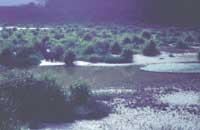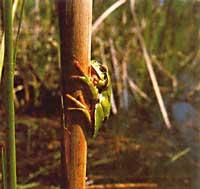There was a treasure in Euskal Herria...
2000/09/01 Txintxurreta Agirre, Arantxa - Elhuyar Zientziaren Komunikazioa Iturria: Elhuyar aldizkaria
Let's start with the beginning. Our protagonist is a frog, a bright green frog that measures about 5 cm. His eyes are large, leaped to the sides and with horizontal black pupils. The eardrum stands out and the rounded end. A black line that goes from the area of the nose on both sides, to the pre-appendices (see large photo). That is, in the hand, certainly the best mark to differentiate from the tree frogs of San Anton ( Hyla arborea; see small photo). However, they can be differentiated in size, aspect of seminarians, running and distribution mainly. And the cast is the reason for our frog being the protagonist.
But before we get into this topic, which would already be getting into the knot, let's know a little more about this raw amphibian. First the name, because I have not mentioned it yet. It has hyla meridionalis, a southern frog among friends. Why that "pseudonym"? On the one hand, for its distribution in the world, and on the other, for living in the trees. On the fingers have adhesive discs to easily ascend trees, bushes and other plants. In this way they spend the day on the branch of a tree, standing. At night they descend and begin to catch insects. Water? Yes, of course. Being amphibians, they need water to reproduce. Shallow wells and few meters are sufficient. However, females need aquatic vegetation to lay eggs and also appreciate that they are not contaminated (this is called irony). In the absence of such wells, they are forced to use some "blue water boxes" of the second protagonist of this story, the so-called pools. But they do not extract any effect (lack of vegetation, cleaning and chlorination are the main reasons). They seem to have a single well: Reservoir of Gurelesa (see figure 1), only place of reproduction of natural beings (Etxezarreta Rubio, 1998, unpublished).
Knot
Well, and with the presentation of the second protagonist we have reached the knot of the story. Its name is Homo sapiens sapiens, common name: The human being. Many of you will know him because he is the protagonist of most stories. In addition to walking on the two legs, its particularity lies in being a well developed brain in the head that has a notorious characteristic that makes it protagonist of several stories.
" Once .."
Although the southern frog is originally Mediterranean, if found in Mendizorrotz, and resembles the last glaciation, it lives in it. The first scientific quotation was made in 1880 by Boscá, who discovered two species of tree frog so similar at that time and which can be found today. Mendizorrotz, Orio, Usurbil and Donostia-San Sebastián are a mountain range delimited by the municipalities and the only residence of the southern frog in the Basque Country (it is suspected that it is in Azparne, but no documentation has been found). In the mountain range also lives the second protagonist, and although in the beginning their ancestors respected the necessary wells, little by little they have eliminated them. At present, on the slopes of Mount Igeldo, only the Gurelesa swamp, mentioned above, and the Berio well, were given to them.
Legal protection yes. No worries?
Given the isolation, relics and/or vulnerability of the frog population, the Basque Government, a powerful human association, declared southern Hyla as "endangered species" in 1996, being the only amphibian with this category in the Basque List of Threatened Species. This figure has legal implications (norms devised by the human being and of obligatory compliance): they cannot die, catch themselves, touch the larvae,... they cannot destroy their habitat, nor their places of reproduction... and a strategic plan must be developed to guarantee the recovery of the species (Law 16/1994, of 30 June), which allows the species to leave the List.
By the end of 1997, however, nothing had been done about it and after the disappearance of the well of Berio, the Cultural Association Haritzalde Naturzale of San Sebastian (a human association without power) gave rise to the alarm. Later another well was built in Berio (see figure 2), but the recovery plan had not been realized. In October 1998 Aranzadi Z.E. (a prestigious human research team) conducted for the Provincial Council of Gipuzkoa (Etxezarreta Rubio, 1998, unpublished) the "Study of the State of the Tree Ranita of the South of Mendizorrotz". The land on which the Gurelesa reservoir is already located was sold by the company Iparlat to a Biscayan company, Neinor. The reservoir was conceived in the 1950s for cleaning milk bottles in water and cooling machines. A few years ago it emptied, but rainwater is enough to maintain the water level and over time has been "naturalized" by abandonment. It is spectacular the fauna and, above all, the flora that exists today. And that is the only place propitious or preferred to be descendants. For these reasons, Haritzalde requested the declaration of the environment as Biotopo Protected, but almost a year later it has received as an "unforeseen" response. However, the area is also suitable for industrial areas and Neinor has a project to build pavilions on the reservoir.
Man dressed in black
Then came a short but important paper character: the prosecutor. He is a powerful and respectful man with many human beings, he is in compliance with the law and if he sees that it is not fulfilled he can ask for sanctions. It was decisive to start the knot of this tale.
Then, three years after its declaration as a threatened species, in November 1999, the Provincial Council of Gipuzkoa published the "Management Plan and complementary standards of protection" of Hyla meridionalis (BOG 221, of 18 November 1999), as required by law. And at the end of the work, the Prosecutor excluded himself from the story, making it clear that if our amphibious protagonist disappears, he will take measures with respect to those responsible.
I hope I haven't lost it so far, reader. I know that it is a complicated knot, many characters, a lot of action, intrigue... but quiet, now let's start to calm the knot and channel it in the end.
I have left the thread in the strategic plan. In short, the plan forces to build other wells on the mountain, 10 in total. Next to the reservoir of Gurelesa will create a new well to which the frogs that came to the Reservoir must access. The well will be used as a central, from where the specimens of the new wells scattered through the mountain will be collected. The idea is to remove frogs from the industrial zone to avoid competition with the human being and recover the division of the frog in Mendizorrotz. However, the Plan DOES NOT SAY what will happen in the Gurelesa reservoir, it does not guarantee the duration of the reservoir that until now is the only place to reproduce while ensuring that it has been reproduced in another well. Because it's important, I'll say it another way to make it clearer. In fact, in the specimens with developed brain, that is, in the H. s. sapiens, the subject of intra-specific competition has been: the maintenance of the Gurelesa Reservoir as a guarantee of survival of the frogs until it is proven/certify that in some new well the reproduction occurs and that the new generation advances. The plan, however, does not indicate it, and once the frogs have passed to the central well, Neinor will have no difficulty building the project pavilion.
End
And we have reached the end of this story. Seven new wells have already been built. The side of the reservoir, central, is also built. Fortunately, Neinor decided not to start the works this summer and by October has left the reservoir disaster. Therefore, the frog has had the opportunity to enjoy its favorite corner for another year and if this summer someone has approached the night area, has been able to check how well this opportunity has welcomed. Often scandal in trying to attract the female to the crazy male choirs!
However, as a reader, you will want to know what has happened in the new wells. For anyone who has been around the night has been able to hear in several new wells, even when I had gone to the central well with water (unfortunately, somewhere I chose a day without water (!!). However, by finding two H. s. sapiens spotlights and saddles, there may be doubt as to whether the frogs have gone on their own or have come as a result of attempts to get away from the frog's disappearance of these two enthusiastic Aranzadi workers. These two researchers will have to resolve their doubts by publishing the conclusions of their work. Meanwhile, questions in the air: will they start making pavilions next month? If so, next summer, will H. meridionalis be able to mold without reservoir? Will we eventually have the Biotope Protected? Is the prosecutor going to do something despite not complying with the Strategic Plan? What opinion will the Deputy General have on all this? Time will tell! The end of the story, therefore, will have to be left for the next section and by then we hope to have answers.
And now, as long as man remains the same, the frog has come to rest: to sleep well the frog, until tomorrow!

Gai honi buruzko eduki gehiago
Elhuyarrek garatutako teknologia






